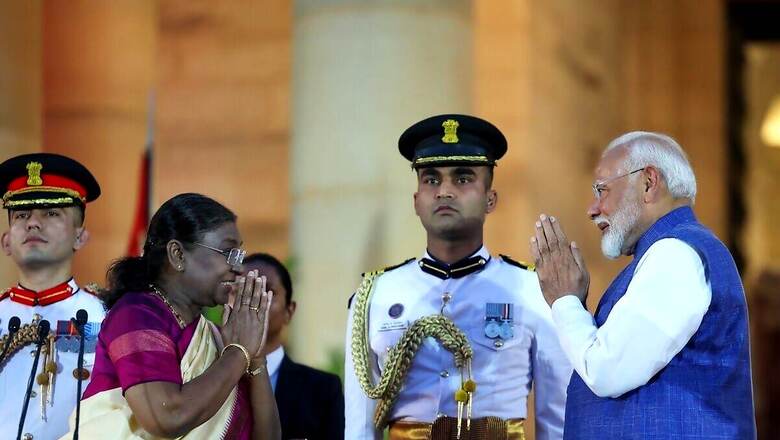
views
When Jawaharlal Nehru became the Prime Minister for the first time in 1947, it was with the grace of Mahatma Gandhi. Gandhi made Nehru the Congress president in May 1946, despite the majority being in favour of Sardar Patel. At that time there were 15 state committees of Congress across the country. Out of them, 12 had supported Patel, while not a single state Congress committee had extended support to Nehru. Due to Gandhi’s wish, Sardar Patel kept himself out of the Congress president race, and as per Gandhi’s plan, Nehru was formally installed on the chair of the president in July 1946.
Back then, everyone knew that whoever would sit on the chair of Congress president would be vice-president of the Viceroy’s Executive Council in the interim government of September 1946 and then become the first Prime Minister of the country after Independence. This is why on August 15, 1947, Nehru became the first Prime Minister of Independent India.
A question that arises is why Mahatma Gandhi forcibly made Nehru the president of the Congress while denying Patel and then in the same capacity made him the first Prime Minister of the country. Gandhi himself has answered this. Following Gandhi’s advice, Sardar Patel could have agreed to accept Nehru’s leadership in the interest of the country and the party, but Nehru could not do the same for Sardar Patel. He was not even averse to leaving the Congress and joining any opposition party. Gandhi’s apprehension was not baseless.
After Gandhi and Patel’s demise, Nehru, who was firmly established as PM by then, did not accept Purushottam Das Tandon as the Congress president over a difference of opinion. Tandon, the elected president of the Congress, had to resign. After Tandon’s resignation, Nehru did not hesitate to grab the post of Congress president, besides being the Prime Minister.
This was the same Nehru, who had said at the time of Independence that the post of Prime Minister and Congress president should not be held by any one person. Soon after Gandhi and Sardar Patel’s demise, Nehru made a complete U-turn from his earlier stand and became the Congress president also. Not only this, Indira Gandhi was made the president of Congress during his lifetime. Dynastic politics started from this move and one after another members of the Nehru-Gandhi family were able to be at the helm of power.
During his last days, Nehru did not leave the PM’s post despite ill health and even ensured that it did not take much time for Indira Gandhi to get the post after his death. Nehru removed most of the strong Congress leaders from power under the Kamaraj Plan from the Centre to the state level. Nehru had become the Prime Minister four times, but his attachment to power and family persisted.
Like her father Nehru, Indira Gandhi also took oath as the Prime Minister four times during her lifetime. But when Indira Gandhi became the Prime Minister for the first time in 1966, she was not presented to the people as the PM candidate in the Lok Sabha elections held before that. The elections were held in 1962 when Nehru was the Prime Minister.
After Nehru’s demise, Lal Bahadur Shastri became the PM in 1964. He too was not projected as the PM candidate in the elections. After Shastri’s demise in Tashkent, Morarji Desai naturally had a claim, being the most experienced leader, but the “syndicate” which had command over the Congress at that time made Nehru’s daughter Indira Gandhi the PM, instead of a “strong” Desai. They did so thinking that this “goongi gudiya” (silent doll) would be weak, would be completely under their control, allowing them to keep driving from the backseat and the power would remain in the hands of the “syndicate”.
Once she came to power, Indira Gandhi only left when the public ousted her in 1977. To protect her government from the Allahabad High Court’s decision to cancel her election in 1975 and the opposition’s strong protests against corruption, Indira Gandhi even imposed Emergency in June 1975, while the term of the Lok Sabha was increased from five to six years. All possible efforts were made to tamper with the Constitution.
In 1977 when elections were held after the Emergency, no one leader from the opposition was put up against Indira as the PM candidate. Morarji Desai was made the Prime Minister as per the wishes of Jayaprakash Narayan, the pioneer of Sampoorna Kranti and the founder of the Janata Party, which stood as a common opposition front against Indira Gandhi. After Desai, Charan Singh became the Prime Minister for a few months. Obviously, he too was not projected as a PM candidate in the 1977 elections.
After October 31, 1984, when Indira Gandhi was assassinated by her security personnel Beant Singh and Satwant Singh, Rajiv Gandhi was sworn in as the Prime Minister. Naturally, Rajiv, who held the post of Prime Minister for the first time, was not projected as the PM candidate in the Lok Sabha elections held before that in 1980.
As far as all the Prime Ministers appointed after Rajiv Gandhi and before Narendra Modi are concerned, none except Atal Bihari Vajpayee was presented before the country as a PM candidate. Even when Vajpayee became Prime Minister for the first time, he could not get a majority for his party or alliance in the elections.
During the 1989 Lok Sabha elections, no person was projected as the PM candidate from the Janata Dal. After the elections, Chandra Shekhar had put forward Devi Lal’s name, but the latter shrewdly pushed for VP Singh as the PM, while he himself became the deputy prime minister. Chandra Shekhar became the Prime Minister after the fall of VP Singh’s government. However, his government too fell within six months.
PV Narasimha Rao became the Prime Minister after the 1991 Lok Sabha elections. Rajiv Gandhi was assassinated during those elections. To provide a wave of sympathy to the Congress like in 1984, the remaining phases of elections after Rajiv’s assassination in 1991 were postponed by the then Chief Election Commissioner TN Seshan. Despite this, the Congress did not get a majority after the completion of the elections. The Congress could not cross the majority figure of 272 and won 244 seats. It formed the government through an alliance with other parties.
Rao was not projected as a PM candidate in the 1991 Lok Sabha elections. He was set to return to Hyderabad after not seeing a future for himself in the party, with plans to retire. The situation that arose after Rajiv’s assassination made him the Prime Minister of the country.
After the 1996 Lok Sabha elections, the government was formed under the leadership of Atal Bihari Vajpayee, whom the BJP had projected as its face and PM candidate. But the BJP did not get a majority. Then President Shankar Dayal Sharma invited Vajpayee to take oath because BJP had emerged as the single largest party. Sharma had given only a fortnight’s time to Vajpayee to prove his majority in the House, but he could not do so and his government fell within 13 days.
It should be noted that when no party got a clear majority after the 1989 Lok Sabha elections, then President R Venkataraman gave preference to the 282 tally of the largest pre-poll alliance between the National Front, Left Front, and the BJP, instead of the Congress, which was the single largest party. The reason was also clear, there was no pre-poll alliance of parties with the Congress which could prove a majority in the House, whereas the opposition had this.
Meanwhile, President Venkataraman, after the 1991 Lok Sabha elections, had given the Congress the advantage of forming the government through the coalition formula. The Congress and its allies together had 241 seats and did not have a majority in the House, yet they were invited to form the government. This was the first minority government in the history of independent India. Earlier, when Venkatraman had invited Chandra Shekhar to form the government after the fall of the VP Singh government, he had sought proof of majority. Chandra Shekhar, who had the support of only 57 MPs, was sworn in as the Prime Minister due to the support given from outside by the Congress.
In the 1996 Lok Sabha elections, no alliance had secured a majority in the House. President Shankar Dayal Sharma invited Vajpayee, the leader of the largest party in the House, to take the oath of office as PM. Vajpayee was the leader of the opposition in the House before these elections, while LK Advani had resigned as the BJP’s leader in the House after the demolition of the Babri Masjid in 1992. Also, he did not contest the 1996 elections after his name was linked to the Jain Hawala Diaries case. The BJP had fought the 1996 Lok Sabha elections keeping Vajpayee at the centre.
President Sharma had set strict conditions for Vajpayee to prove his majority in the House and gave him very little time. He was asked to prove the majority in the House within just a fortnight, which was much less compared to previous occasions. Earlier, President Venkataraman gave a month to both VP Singh and Rao to prove their majority in the House.
When Vajpayee resigned on May 28, 1996, over apprehensions of not being able to prove his majority in the House, Shankar Dayal Sharma invited HD Deve Gowda to take oath on June 1, 1996. Being the 11th Prime Minister of the country, Deve Gowda had to prove his majority by June 12. He was able to do so with the support of the Congress. Obviously, Deve Gowda was not projected as the PM candidate by the United Front in the 1996 Lok Sabha elections, nor was Inder Kumar Gujral, who took over as Prime Minister after Deve Gowda’s resignation.
In both 1998 and 1999, the NDA governments were formed under the leadership of Vajpayee and the BJP was the largest party. While the 1998 government fell within 13 months due to a lack of majority, only Vajpayee’s third term government formed in 1999 was able to complete its full five-year tenure.
When the Lok Sabha elections were held in 2004, no one was projected for the post of Prime Minister by the UPA. It was Sonia Gandhi’s very public decision to make Manmohan Singh the PM. Manmohan had not even contested the Lok Sabha elections.
Narendra Modi is the only person in the history of independent India, who held the post of Prime Minister for the first time when he was presented as the PM candidate in the Lok Sabha elections. He was successful in getting a majority for his party. Modi, who created this record in 2014, was able to form the government once again in 2019 when the BJP won 303 seats on its own.
In the 2024 Lok Sabha elections, the NDA under his leadership won 292 seats (including BJP’s 240), which is 20 more than the majority figure in the House. As per tradition, President Droupadi Murmu had no option other than inviting Narendra Modi as the leader of the largest pre-poll alliance or the largest party.
After all, how could she think of anything else? In India’s history, governments have also been formed when at the time of receiving the invitation, the PM pick, party, or coalition did not even have the majority figure. Here, the NDA had a clear majority.
With the victory of 2024, Modi has also created a unique record of appearing before the public as a prime ministerial candidate from the first to the third time and getting a majority for his party or pre-poll alliance every time. This “hat-trick” is special, unique, and a record in Indian politics.















Comments
0 comment